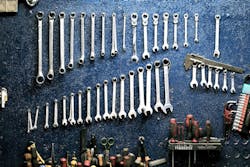Photo estimates might seem like a straightforward process that will take care of itself but there’s more to it than meets the eye to bring in more customers.
For Anthony Kupbens, he has discovered in a short time how photo estimates can expand the jobs coming into the collision repair facility. Kupbens, assistant manager for Hendrick Collision Center in Concord, N.C., says he was able to capture a $10,000 repair through the Bodyshop Booster estimating tool, which allows body shops to reach customers that normally would be too far out of the market.
The collision repair center has become a sort of “pilot program” for photo estimates in the repair process, he says. So, with venturing into using a new estimate platform, Kupbens has realized there are more moving parts to the process than it appears.
While Kupbens has been at the center for 1.5 years, he pitched the idea of offering a photo estimating service in March 2018.
“We thought it would severely decrease foot traffic but, instead, it opened a wider clientele,” Kupbens says.
Kupbens was worried that by offering the customer an option to send in photos for an estimate and never step foot into the shop, that he would lose business, but he found that the service actually expanded his market area because he could offer services to people located further away from the shop.
Beginning the “Pilot” Program
A collision repair consultant the managers were acquainted with through a manufacturing partner recommended the photo estimating service Bodyshop Booster to Kupbens.
“I liked the user interface and how easy it was for a customer to use the application,” he says.
In March 2018, Kupbens began using the program. At the start, he assigned it to one employee out of his staff of 50 (which includes a front office staff of 16 people).
The process was simple but took a long time because the shop only had one person to handle all the requests coming through, he says. The person handling the estimates started by sending the customer a request to use it and then requesting he or she call into the office. One person received a workload of five to seven requests per day, which included contacting the customer, waiting on the customer and writing the estimates.
“We struggled with the turnaround time of finishing the estimates,” he says.
Identifying the Kinks
Kupbens and his team did not start the process without issues. By having only one person work on the photo estimates alone, it took that employee 24 hours to turn around just one estimate.
While the process took a full day, the shop also started to see an increase in volume of jobs coming through—which was both a blessing and a curse.
“We’re in the north point of Charlotte, N.C., and we have now had customers from south Charlotte sending estimate requests in to the shop,” Kupbens says.
To circumvent those issues, Kupbens kept customers informed that they still have the option to come into the shop to complete the estimate.
At the time, the shop, on average, received six requests per day. So, Kupbens went back to the start and decided to disperse assignments more evenly. He started giving each of his estimators the responsibility of using the tool.
Dividing Responsibility
Once Kupbens realized one person could not handle the volume of work, he decided to assign more people to handle the photo estimating process.
Instead of one person handling the calls and writing the estimates, he created a “round robin” structure to the process. Here’s how it works:
Now, each of the six estimators works on 1–2 of the photo estimate requests per day. Once the estimate request comes in, the front office administrators upload it to CCC ONE and send it to Kupbens for a brief check. Kupbens checks it over and determines if the estimate can be done as a photo estimate and if it’s a less severe repair job, which he categorizes as a category one or category two. If it is only a minor repair, he dispatches the estimate to one of the estimators, and the team records the date and the person working on the estimate.
In total, the new process takes roughly two to three hours, if the shop is especially busy, but can take as little as 20 minutes, he says.
And, Kupbens recently hired an additional estimator who focuses on bringing the process from the one dealership collision repair shop to the other ones. The new hire is already familiar with virtual estimates thanks to work at a previous position, he says.
Looking Forward
Kupbens has learned photo estimates do not only have one benefit—they actually have three.
He has seen a pay-off in customer satisfaction because the process is easy and saves time for the customer. He makes it so the customer only has to visit the shop twice: once to drop off the vehicle and another time to pick up the vehicle.
If a customer calls in, Kupbens pitches the easy process of writing a preliminary estimate, ordering parts, calling the customer the same day to schedule the repair and having everything ready to start the repair once the vehicle is brought in.
The photo estimating process opens up an influx of jobs from the dealership service lanes. Kupbens says he recently walked through the service drive and found 10 vehicles that could go through the process for cosmetic repair. Along with the increased amount of work, he says it also builds a rapport with customers who then keep the body shop in mind later on in the event of an accident.
And, the last benefit derives from links that are not being actively marketed to customers. These are links that a customer can find on his or her own when searching the website and click through. The customer can search the shop’s website and simply click through the process and receive an estimate in a few hours.



